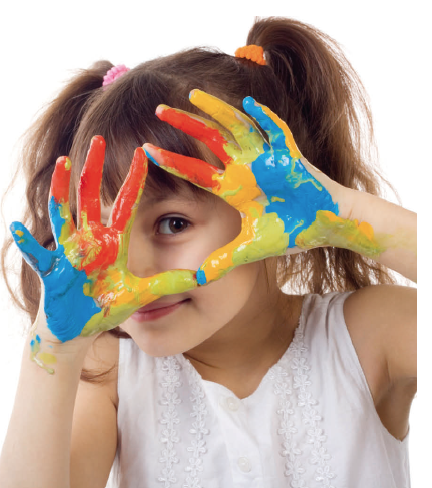
Nurturing learning through Colour
You’ve probably noticed that colour influences your mood, but
have you stopped and considered how you can use colour to
enhance learning and influence mood in the classroom or other
educational environments? The colours you choose to use in your
classroom or centre can actually have a major impact on children’s
mood and how children learn and absorb information. For example,
using yellow in your classroom will encourage children to be creative
and will also help you maintain their attention.

Infants only see black and white when they are born,
so providing bright colors in their environment will help
their brains learn to recognize colour. Wrapping red
fabric around bottles or placing red placemats under
children’s plates will help even the pickiest of eaters get
the nutrition they need. Using crib linens and flooring
designs in cool colors (blue, green, purple) can calm
children and help them rest better.
There are also several ideas you can implement for
pre-school children. Wearing a yellow or off-white apron
or smock when you present information to children can help
maintain their attention. In areas where children need to be
attentive such as classroom floor surfaces and furniture,
try placing a yellow placemat, a yellow vase of flowers,
a picture of yellow flowers, a yellow folder, or a yellow
pencil case to help them pay attention. Using calming
colours (different shades of blue, beige, and green) in
quiet areas can calm children and help them feel relaxed.
You can teach school age children about how colour
affects their moods, appetites, behaviour, and learning
by asking questions about how they feel around certain
colours and whether they agree with research findings
about the impact of colour.
Some institutions create breakout flooring schemes using
multiple colours to provide a difference in space and
visual impact.
Include a discussion about colour-related phrases
(e.g., feeling blue, seeing red, true blue, having a green
thumb) in your lesson plans. Ask children if the phrases
and their meanings match their experiences with colour.
Make an effort to display art from different artists in your
classroom. The artwork you choose can lead to discussions
about why the artists chose certain colours and how they
used colours to create emotional reactions to their work.
For Small or Large Groups, hang crepe paper
streamers to influence the moods in certain areas.
For example, dark-coloured streamers in a reading area
would help children relax and focus on what they are
reading. Use reds and yellows in areas where you would
like to encourage creativity (e.g., art learning centre,
dramatic play learning centre, writing area/learning centre).
Consider the effects of colour when planning family
engagement events or other classroom activities.
Bright flooring schemes may overstimulate children if they
are already excited so consider calming or neutral floors.
For further information on designing your flooring scheme to aid learning through colour – please contact us or find an Education Flooring Consultant below.


